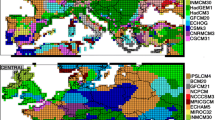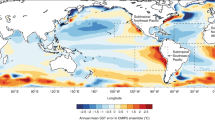Abstract
Climate engineering (CE) deployment would alter prevailing relationships between Earth system variables, making indicators and metrics used so far in the climate change assessment context less appropriate to assess CE measures. Achieving a comprehensive CE assessment requires a systematic and transparent reevaluation of the indicator selection process from Earth system variables. Here, we provide a first step towards such a systematic assessment of changes in correlations between Earth system variables following simulated deployment of different CE methods. We therefore analyze changes in the correlation structure of a broad set of Earth system variables for two conventional climate change scenarios without CE and with three idealized CE model experiments: (i) solar radiation management, (ii) large-scale afforestation, and (iii) ocean alkalinity enhancement. First, we investigate how the three CE scenarios alter prevailing correlations between Earth system variables when compared to an intermediate-high and a business-as-usual future climate change scenario. Second, we contrast the indicators identified for the non-CE climate change scenarios and the indicators identified when all five scenarios are considered. Finally, we use the identified indicator sets for an evaluation of the five climate change scenarios. We find that the additional indicators provide valuable information for the assessment of the CE measures, and their application hence allows for a more comprehensive and a comparative assessment of the mitigation and CE deployment scenarios.






Similar content being viewed by others
References
Bitz CM, Lipscomb WH (1999) An energy-conserving thermodynamic model of sea ice. J Geophys Res 104(C7):669–677. https://doi.org/10.1029/1999JC900100
Böhringer C, Jochem PEP (2007) Measuring the immeasurable. A survey of sustainability indices. Ecol Econ 63(1):1–8
Burke M, Hsiang SM, Miguel E (2015) Global non-linear effect of temperature on economic production. Nature 527(7577):235–239
Cox PM (2001) Description of the TRIFFID dynamic global vegetation model. Hadley Cent Tech Note 24:1–16
Cox PM, Huntingford C, Harding RJ (1998) A canopy conductance and photosynthesis model for use in a GCM land surface scheme. Journal of Hydrology 212–213:79–94 URL http://linkinghub.elsevier.com/retrieve/pii/S0022169498002030
Ebert U, Welsch H (2004) Meaningful environmental indices: a social choice approach. J Environ Econ Manag 47(2):270–283
Eby M, Weaver AJ, Alexander K, Zickfeld K, Abe-Ouchi A, Cimatoribus AA et al (2013) Historical and idealized climate model experiments: an intercomparison of Earth system models of intermediate complexity. Clim Past 9:1111–1140
Fanning AF, Weaver AJ (1996) An atmospheric energy-moisture balance model: climatology, interpentadal climate change, and coupling to an ocean general circulation model. J Geophys Res 101(D10):111–115
González MF, Ilyina T (2016) Impacts of artificial ocean alkalinization on the carbon cycle and climate in Earth system simulations. Geophys Res Lett 43:6493–6502. https://doi.org/10.1002/2016GL068576
Hunke EC, Dukowicz JK (1997) An elastic-viscous-plastic model for sea ice dynamics. J Phys Oceanogr 27(9):1849–1867
Irvine PJ, Sriver RL, Keller K (2012) Tension between reducing sea-level rise and global warming through solar-radiation management. Nat Clim Chang 2(2):97–100
Irvine PJ, Kravitz B, Lawrence MG, Gerten D, Caminade C, Gosling SN et al (2017) Towards a comprehensive climate impacts assessment of solar geoengineering. Earth’s Future 5(1):93–106
Keller DP, Oschlies A, Eby M (2012) A new marine ecosystem model for the University of Victoria Earth system climate model. Geosci Model Dev 5:1195–1220
Keller DP, Feng EY, Oschlies A (2014) Potential climate engineering effectiveness and side effects during a high carbon dioxide-emission scenario. Nat Commun 5:3304
Keller DP, Lenton A, Littleton EW, Oschlies A, Scott V, Vaughan NE (2018) The effects of carbon dioxide removal on the carbon cycle. Curr Clim Chang Rep 4(3):250–265
Klepper G, Rickels W (2014) Climate engineering: economic considerations and research challenges. Rev Environ Econ Policy 8(2):270–289
Kravitz B, Robock A, Boucher O, Schmidt H, Taylor KE, Stenchikov GL, Schulz M (2011) The geoengineering model intercomparison project (GeoMIP). Atmos Sci Lett 12(2):162–167
Kravitz B, Caldeira K, Boucher O, Robock A, Rasch PJ, Alterskjær K, Karam DB, Cole JNS, Curry CL, Haywood JM, Irvine PJ, Ji D, Jones A, Kristjánsson JE, Lunt DJ, Moore JC, Niemeier U, Schmidt H, Schulz M, Singh B, Tilmes S, Watanabe S, Yang S, Yoon JH (2013) Climate model response from the Geoengineering Model Intercompari- son Project (GeoMIP). J Geophys Res Atmos 118(15):8320–8332. https://doi.org/10.1002/jgrd.50646
Lunt DJ, Ridgwell A, Valdes PJ, Seale A (2008) “Sunshade World”: a fully coupled GCM evaluation of the climatic impacts of geoengineering. Geophys Res Lett 35:L12710. https://doi.org/10.1029/2008GL033674
Meinshausen M, Smith SJ, Calvin K, Daniel JS, Kainuma MLT, Lamarque JF et al (2011) The RCP greenhouse gas concentrations and their extensions from 1765 to 2300. Clim Change 109(1-2):213
Meissner KJ, Weaver AJ, Matthews HD, Cox PM (2003) The role of land surface dynamics in glacial inception: a study with the UVic Earth System Model. Clim Dyn 21(7–8):515–537.
Mengis N, Keller DP, Eby M, Oschlies A (2015) Uncertainty in the response of transpiration to CO2 and implications for climate change. Environ Res Lett 10(9):094001
Mengis, N., T. Martin, D. P. Keller, and A. Oschlies (2016), Assessing climate impacts and risks of ocean albedo modification in the Arctic, J. Geophys. Res. Oceans 121:3044–3057, https://doi.org/10.1002/2015JC011433.
Mengis N, Keller DP, Oschlies A (2018) Systematic correlation matrix evaluation (SCoMaE) – a bottom–up, science-led approach to identifying indicators. Earth Syst Dynam 9:15–31. https://doi.org/10.5194/esd-9-15-2018
Moreno-Cruz JB, Ricke KL, Keith DW (2012) A simple model to account for regional inequalities in the effectiveness of solar radiation management. Clim Chang 110:649–668. https://doi.org/10.1007/s10584-011-0103-z
Oschlies A, Held H, Keller DP, Keller K, Mengis N, Quaas M, Rickels W, Schmidt H (2017) Indicators and metrics for the assessment of climate engineering. Earth’s Future 5:49–58
Pacanowski RC (1995) MOM 2 documentation, users guide and reference manual, GFDL Ocean Group Technical Report. Geophys. Fluid Dyn Lab, Princeton University, Princeton, p 3
Rickels W, Quaas M, Visbeck M (2014) How healthy is the human-ocean system. Environ Res Lett 9:044013
Sonntag S, Ferrer Gonzlez M, Ilyina T, Kracher D, Nabel JEMS, Niemeier U, Pongratz J, Reick CH, Schmidt H (2018) Quantifying and comparing effects of climate engineering methods on the earth system. Earth’s Future. https://doi.org/10.1002/2017EF000620
Sterner T, Persson UM (2008) An even sterner review: introducing relative prices into the discounting debate. Rev Environ Econ Policy 2(1):61–76
Stocker T et al (2013) Climate change 2013: the physical science basis. In: Working Group 1 (WG1) Contribution to the Intergovernmental Panel on Climate Change (IPCC) 5th Assessment Report (AR5), Cambridge and New York
Weaver AJ, Eby M, Wiebe EC, Bitz CM, Duffy PB, Ewen TL et al (2001) The UVic Earth System Climate Model: Model description, climatology, and applications to past, present and future climates. Atmosphere-Ocean 39(4):361–428
Acknowledgements
The authors thank Wolfgang Koeve and Ulrike Loeptien for the helpful comments and discussion, as well as the participants of the Metrics Workshop of the SPP 1689 in March 2015, Hamburg, and in April 2016 in Kiel, for their thoughts on metrics and indicators.
Funding
This work was funded by the DFG Priority Program: Climate Engineering: Risks, Challenges, Opportunities? (SPP 1689).
Author information
Authors and Affiliations
Contributions
N.M., D.P.K., W.R., M.Q., and A.O. conceived the experiment. N.M. and D.K. implemented and performed the simulations. N.M. and W.R. analyzed the data and wrote the manuscript with contributions from D.P.K., M.Q., and A.O.
Corresponding author
Ethics declarations
Conflict of interest
The authors declare that they have no competing interests.
Additional information
Publisher’s note
Springer Nature remains neutral with regard to jurisdictional claims in published maps and institutional affiliations.
Electronic supplementary material
ESM 1
(PDF 1762 kb)
Rights and permissions
About this article
Cite this article
Mengis, N., Keller, D.P., Rickels, W. et al. Climate engineering–induced changes in correlations between Earth system variables—implications for appropriate indicator selection. Climatic Change 153, 305–322 (2019). https://doi.org/10.1007/s10584-019-02389-7
Received:
Accepted:
Published:
Issue Date:
DOI: https://doi.org/10.1007/s10584-019-02389-7




